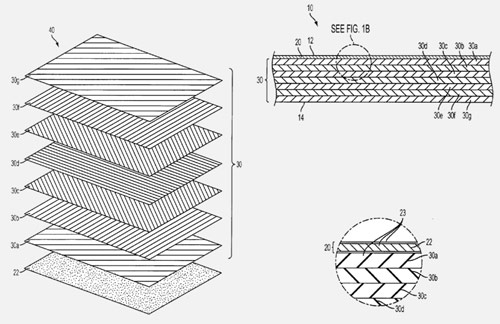Back in November we wrote about the possibility of Apple using carbon fiber in its next generation Air notebook. Fast forward almost 6 months forward, and there has been an interested development in this rumor. A recent patent filing by Apple now confirms that they are at the very least exploring the idea of using carbon fiber in at least one of their products…not just the Air. We first read the report on AppleInsider, although the news has been all over the internet now.
The 9-page filing explains that carbon fiber reinforced plastic (aka carbon fiber composites) provide a strong, lightweight material for forming housings for electronic devices and portable computers. Note that this line essentially allows us to believe that it’s possible they are interested in using carbon fiber in not only their portable computers but potentially other devices…think iPod and iPhone, or even something else not yet released.
They also discuss how the traditional method of laying sheets of carbon fiber material into a mold and then filling it with resin, as well as some other methods are no good from them. The reason? They almost always show a black color with the woven carbon fibers visible on the surface…your typical carbon fiber that we all know and love. They don’t like this:
“In addition, the fibers (either as a unidirectional, woven, or nonwoven substrate) are typically variable in their construction and therefore are variable in their surface presentation,”
“As a result, the resulting carbon fiber composite can have cosmetic imperfections that reduce the aesthetic appearance of the molded article formed therefrom. Further, carbon fiber composites, often being black, provide a narrow range of surface appearance to the molded article and therefore may give a ‘tired,’ unexciting look.”
So basically because of the black look and slight cosmetic imperfections, Apple doesn’t want to head down that route. They’ve devised a solution to the problem, which is best described by them:
A composite laminate having an improved cosmetic surface is presented herein. The composite laminate includes a plurality of sheets of preimpregnated material, or prepreg, stacked one over another and a scrim layer provided on an exterior surface of the sheets of prepreg. The scrim layer and the sheets of prepreg form a composite laminate whereby the scrim layer constitutes an outer, exposed surface of the composite laminate. Each sheet of prepreg is made from fibers preimpregnated with resin, and the fibers of the prepreg may be substantially parallel or woven carbon fibers. The scrim layer may be a glass fiber or carbon fiber scrim, or veil, that has absorbed resin from the sheets of prepreg during a molding process. In another embodiment, the composite laminate includes a plurality of sheets of prepreg stacked one over another and first and second scrim layers provided on opposing exterior surfaces of the sheets of prepreg, whereby the sheets of prepreg are sandwiched between the first and second scrim layers. The first and second scrim layers constitute exposed surfaces of the composite laminate.

Essentially since scrim absorbs the resin of the composite, it ends up taking on the cosmetic properties and color of the resin. The underlying fibers below are still visible, it should be an interesting look that we’re dying to see.
Scanning through some of the commentary, the best guess I’ve seen for what Apple really wants to use this for is their rumored tablet device. 8CoreWhore made this assumption that we liked:
This may not be for the MacBook/Pro’s. My guess is it’s for the so called tablet. First – with a laptop, you need the bottom to be heavier than the lid or it’ll tip over. But if you’re making a very thin tablet or basically larger Touch/iPhone, with an OLED screen, you need a very rigid, light back for it. Imagine a touch that was three times larger, but then you’d immediately lose rigidity at that size! Only aluminum unibody would be rigid enough if using aluminum, but then the device would be too thick and the aluminum would interfere with the radios. So a form of plastic it is, but carbon fiber is best – but they don’t want it to look like typical CF and they don’t want to paint it -thus the scrim layer.
It seems to make sense that Apple would want the extreme lightweight for a lid of a device so it doesn’t topple over. We are expecting announcements this Summer for a iPhone version 3.0, would it be too early to see an announcement about the use of carbon fiber? Feel free to post a comment about your guesses regarding what they may use the material for.
In case you’re wondering what the weight advantages are, reportedly it would shave about 100 grams off the Macbook Air, dropping the weight from 1363 grams to 1263 grams (from a little over 3 lbs to 2.78 lbs), while also raising production costs.